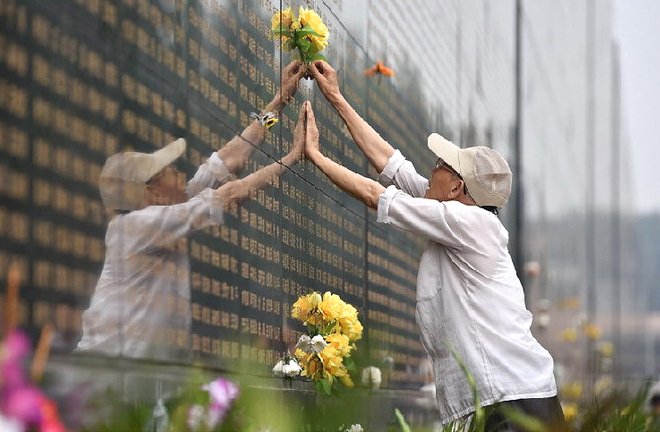Tangshan earthquake: Forty years on

Inside the Tangshan Earthquake Ruins Memorial Park, the names of the victims are inscribed on the Memorial Wall. A Tangshan citizen attaches a bouquet of flowers beneath the name of his relative, one of the victims, for commemoration.
At exactly 3:42 a.m. on July 28, 1976, one of the greatest earthquakes in China’s recorded history struck Tangshan, Hebei Province, leaving approximately one-quarter of the city’s one million residents dead and its infrastructure in ruins.
In the past 40 years, the city has experienced rebirth. In anticipation of the 40th anniversary of the Tangshan earthquake, a CSST reporter visited this coastal city to bear witness to the miraculous progress it has made since the disaster.
It was at noon when the CSST reporter arrived at the Tangshan Earthquake Memorial. According to the tour guide, Tangshan—home to China’s first standard-gauge railway and cement plant—was a symbol of industrialization and progress.
Were it not for the memorial, people would perhaps forget the cataclysm, which claimed the lives of nearly 240,000 people and in some cases, wiped out entire families. The word “unimaginable” is hardly adequate to describe what happened in Tangshan to visitors to the memorial, and for those who witnessed it, the horror was indescribable.
The earthquake leveled the old library of Hebei Polytechnic University, formerly named the Tangshan College of Mining and Metallurgy as it neared completion. Today, the site has become an important place for teaching and research on geology, tectonics and seismogeology. A total of nearly 1,000 experts and scholars from about 50 countries have come for a visit, which has contributed to their mutual academic exchanges.
Five kilometers from the library, there are several similar ruins of building inside the Tangshan Earthquake Ruins Memorial Park. In front of the Memorial Forest, the names of the victims are inscribed on the Memorial Wall.
A taxi driver recounted his memories about the disastrous incident. Now 46 years old, he has a scar on his right leg from an injury he suffered during the disaster, which hit when he was only a boy of six. His parents worked outside their hometown when the earthquake came like a bolt from the blue. He and his 10-year-old brother lived in their maternal grandmother’s home, which helped them escape from the disaster. But his paternal grandmother and grandfather as well as three aunts lost their lives. Later on, he and his brother were sent to Chengdu, Sichuan Province, by their father, where they lived for 10 years before returning to Tangshan.
Many locals are reluctant to mention the earthquake years ago. But when bumping into non-native reporters, some of them take the initiative to talk about it. “Today’s Tangshan is really beautiful. It is almost as if nothing ever happened. But the memory will eternally be imprinted on everyone’s mind,” the taxi driver said.
Chang Qing, now over 60, is one of the survivors. Chang, a photographer by trade, is currently documenting Tangshan’s revival through videos and pictures. His work covers the aftermath of the earthquake as well as post-disaster relief, reconstruction and development. He not only portrays the efforts undertaken to rebuild hospitals, enterprises, schools and libraries during the past four decades but also the lives of children orphaned in the disaster.
“The city grew from the ruins and restarted from scratch,” he said. “Past memories provide an intellectual legacy that drives the construction of a new Tangshan.”
After the calamity, the Central Committee of the Communist Party of China and the State Council rallied the nation to take decisive and effective measures in response to the crisis.
Wang Ziping, a survivor of the earthquake and a sociologist who specializes in natural disaster, said that Tangshan emerged from the ruins like a phoenix from the ashes. In their response to the disaster, Tangshan people remained undaunted by the setbacks, sharing joy and sorrow and demonstrating the tenacity needed to withstand the test of time.
